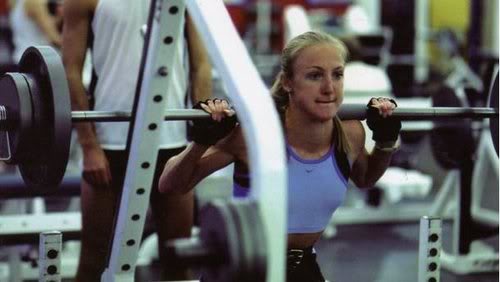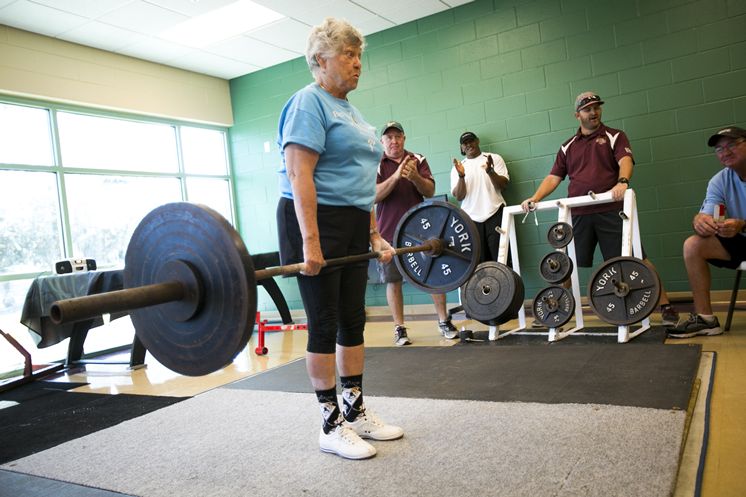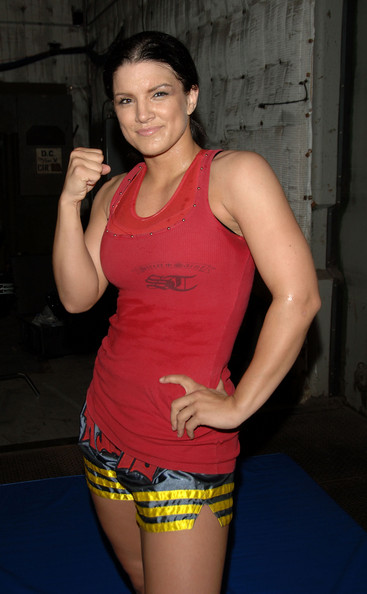Who should be strong and why?
Clearly athletes benefit from more strength, but what about someone who doesn’t label him or herself an “athlete?” Well, strength is like money in the bank: No one ever complained about having too much. No matter who you are, you will benefit from more strength. Here’s a list of who can benefit from strength and why:
- Endurance athletes

Paula Radcliffe holds the women’s world record in the marathon. That looks to be about 150-160 lbs. that she’s squatting.
Plenty of research exists showing that the ability to put more force into the ground, into the pedals or into the water will make you faster. For runners, heavy strength work enhances the spring-like qualities of the Achilles tendon and other connective tissue that aids in running. More strength can help the endurance athlete maintain good form as he or she tires during an event.
- Senior citizens
I mentioned previously that proper strength work creates stronger bones. That’s good for anyone with bone density issues. Beyond that, strength goes hand-in-hand with balance. Strength enables you to better keep yourself from falling and it will help you get up if you fall. -
Do you want to look good?
It’s interesting, when you get strong, you tend to look strong. Posture often improves as part of the process. For a lot of people, heavy strength work works nicely to stimulate the metabolism, especially if they’re new to heavy lifting. Further, multi-joint exercises like squats, push-ups and the like do a great job of creating impressive arms, shoulders, legs and all the rest. - Do you do any manual labor?
Any kind of yard work, house work, moving and carrying stuff, putting stuff overhead, shoveling snow, going up and down stairs etc. will be a lot easier if you’re stronger. The work you do in the gym should enhance your life outside the gym. Exercises like squats, presses and deadlifts loaded with enough weight will definitely help with manual labor.
-
Do you like to feel good?
Strength training carries some impressive and interesting psychological effects. A review of literature from the University of Georgia found the following psychological benefits from weight training:“The weight of the available evidence supported the conclusion that strength training is associated with reductions in anxiety symptoms among healthy adults (5 trials); reductions in pain intensity among patients with low back pain (5 trials), osteoarthritis (8 trials), and fibromyalgia (4 trials); improvements in cognition among older adults (7 trials); improvements in sleep quality among depressed older adults (2 trials); reductions in symptoms of depression among patients with diagnosed depression (4 trials) and fibromyalgia (2 trials); reductions in fatigue symptoms (10 trials); and improvements in self-esteem (6 trials). “
(From my observations: For some magical reason, deadlifting a new 3-rep max has a much more powerful and positive effect on the mind and emotions than does curling 2 lb. periwinkle dumbbells for 30 reps.)
How to get strong
-
Reps and sets:
In a nutshell, the way to get stronger is to lift heavy. How heavy? Look at the chart. If the training objective is strength then we’re looking at lifting something for fewer than six reps. The weights used are 85% of your 1-rep max (1RM) or greater.Effective set/rep schemes include: 2-5 sets of 5 reps, 3 sets of 3 reps, 5 sets of 2 reps and 6 sets of 1 rep.
-
Exercises:
The best strength-building exercises are multi-joint exercises. They include but aren’t limited to the following:- squats
- deadlifts
- overhead press
- bench press
- rows
- cleans
- snatches
- push-ups
- pull-ups
A solid strength workout can be built around one or two, maybe three of these exercises (squat, overhead press, row for example). There’s no need to do them all in one workout.
In contrast, single-joint exercises like bicep curls, tricep extensions, leg extensions/curls and calf raises aren’t as well suited to enhancing strength. They have their place and they can be included in your strength workout but never at the expense of the big lifts.
Most of these exercises except for push-ups and pull-ups should be done with a barbell. Other implements like dumbbells and kettlebells can certainly be used but a barbell is the ideal tool for this type of work. As push-ups and pull-ups become easy, weight can be added.
Remember, the idea here is to increase your strength. That means weight should be added to the exercises from week to week. You can also add reps to the already-challenging weight you’re lifting. Accordingly, you should track your weights, sets and reps. You should strive for progress.
Finally, good form is vital! Heavy lifting is quite safe when done properly. If you’re hesitant then you should seek out a good strength coach or personal trainer. It’s difficult to learn how to do these exercises without good coaching. Reading a magazine article or watching other people in the gym probably won’t quite cut it.
To wrap up
I hope I’ve convinced you of the value of strength. When we’re strong we tend to look and feel strong. Through strength training we can build a strong healthy, useful body without any worry of looking overly muscular. Remember, you can get very strong with virtually no risk of looking “too big.” Sorry, I’m wrong. It’s impossible for you to get “too big.”
Seeing progress in the gym builds confidence and enthusiasm and gives purpose to our workouts. We should expect progress from exercise. Watching the weights go up is a great way to quantify our work in the gym.
Strength has real-world use. It enhances athletic performance and allows us to better take on life’s daily challenges. Strength can keep us safe too, especially from falls and injuries.
Finally, for you to get strong you must lift heavy!
More resources
I didn’t invent any of this information presented here. If you’re interested in learning more, here are some books and online resources for you. There are lot more resources out there. Don’t get confused though: To get strong, pick up something heavy! (Have I said something like that already?)
-
Books
-
Power to the People, Pavel Tsatsouline
-
Starting Strength, Mark Rippetoe & Lon Kilgore
-
Practical Programming for Strength Training, Mark Rippetoe & Lon Kilgore
-
Easy Strength, Dan John & Pavel Tsatsouline
-
-
Online



